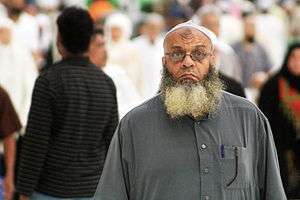Prayer bump

A zebibah (Arabic زبيبة zabība, "raisin"), also known as a zabiba or zebiba, or browneye, is a mark on the forehead of some Muslims, apparently due to the friction generated by repeated contact of the forehead with the prayer mat during daily prayers.
Islam requires its adherents to pray five times a day (known as salat), which involves kneeling on a prayer mat and touching the ground with one's forehead. When done firmly for extended periods of time, a prayer bump may develop. Some Muslims may consider the presence of a prayer bump to be a sign of religious dedication and piety.[1] Some Muslims also believe that on the day of judgment, this bump will particularly fluoresce an immense white light.[2]
In extreme cases, the callus can be thick enough to create a real bump that protrudes from the forehead. They may also develop due to frequent prayer on hard surfaces such as stone floors.
A zebibah can be a type of acanthosis nigricans which is a sign of insulin resistance usually from type 2 diabetes. In Egypt, where zebibahs are common, the rate of diabetes was 10.2% in 2000. However, it was much larger for certain groups. For instance, the rate of diabetes was 21.9% for women aged between 45–64 years old. In addition, it was estimated that up to 56% of men and 64% of women are obese. Many of these obese people can be pre-diabetic.[3]
References in literature
Paul Theroux mentions dealing with a Sudanese official with a prayer bump in his book Dark Star Safari.
In Salman Rushdie's novel Shame, set in Pakistan, the prayer bump is referred to as a "gatta, the bruise of devotion" found on the foreheads of several devout characters.[4]
References
- ↑ Michael Slackman (December 18, 2007). "Fashion and Faith Meet, on Foreheads of the Pious". New York Times. Retrieved 2011-01-10.
- ↑ Magdi Abdelhadi (23 June 2008). "Signs of division on Egypt's brow". BBC News. Retrieved 2011-01-10.
- ↑ Diabetes mellitus in Egypt: risk factors, prevalence and future burden
- ↑ Rushdie, Salman. Shame. Retrieved 11 February 2016.
External links
- Reference to a prayer bump in 'Men, Women and God(s)'
- Mention of a prayer scar in Middle East Report
- Mention of a prayer scar in Occupation Magazine